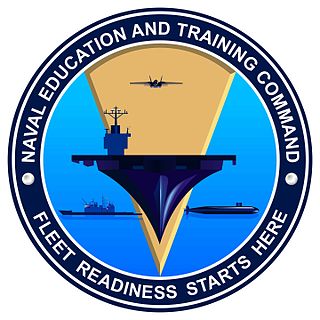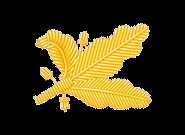The Fleet Marine Force Warfare Insignia, also known as the Fleet Marine Force badge or FMF pin, are three military badges of the United States Navy which are issued to those U.S. Navy officers and sailors who are trained and qualified to perform duties in support of the United States Marine Corps. There are currently three classes of the Fleet Marine Force pin, being that of enlisted, officer, and chaplain.

The surface warfare insignia is a military badge of the United States Navy which is issued to U.S. Navy personnel who are trained and qualified to perform duties aboard United States surface warships. There are presently four classes of the surface warfare pin, being that of line, staff, special operations, and enlisted. The line and enlisted surface warfare badges may be earned by United States Coast Guard personnel assigned to Navy commands. The various badge types are as follows:
The Naval Aviation Supply Corps insignia is a military badge of the United States Navy which is awarded to Naval Aviation Supply Officers (NASOs) of the Navy Supply Corps who have qualified for duties as a Supply Officer in support of naval aviation and are also qualified to serve in duty assignments onboard aircraft carriers. The Aviation Supply Corps insignia is one of four warfare badges issued to Supply Corps officers by the U.S. Navy. The others are the Navy Expeditionary Supply Corps Officer Badge, Surface Warfare Supply Badge, and the Submarine Supply Corps Badge.
The Enlisted Aviation Warfare Specialist (EAWS) insignia is a military badge of the United States Navy which was created in March 1980. The insignia recognizes those members of the Navy's enlisted force who have acquired the specific professional skills, knowledge, and military experience that result in qualification for service in the aviation activities of the Navy. This includes most personnel who are trained flight deck personnel onboard aircraft carriers, or maintenance personnel at an Aircraft Intermediate Maintenance Detachment or Department (AIMD) or aircraft squadron.

Insignias and badges of the United States Navy are military badges issued by the United States Department of the Navy to naval service members who achieve certain qualifications and accomplishments while serving on both active and reserve duty in the United States Navy. Most naval aviation insignia are also permitted for wear on uniforms of the United States Marine Corps.

The Command at Sea insignia is a badge of the United States' seagoing services worn by officers on their uniforms to denote that they are the commander, or formerly a commander, of a warship. If the wearer is currently the commander of a warship, it is worn above the nametag, which is worn a quarter of an inch above the right chest pocket on a uniform shirt. Afterwards, the pin is moved to the left side of the shirt or jacket. For the commanders of land-based installations, a different but similar version known as the Command Ashore insignia instead.

A cryptologic technician is a United States Navy enlisted rating or job specialty. The CT community performs a wide range of tasks in support of the national intelligence-gathering effort, with an emphasis on cryptology and signal intelligence related products.

The Naval Education and Training Command (NETC) is an enterprise level shore command of the United States Navy with more than 19,000 military and staff personnel at more than 1,640 subordinate activities, sites, districts, stations, and detachments throughout the world.
An Engineer Officer is one type of officer in the UK Royal Navy. There are also Warfare Officers and Logistics Officers supported by additional branches such as Medical or Dental Officers, or the Chaplaincy Service.

Postal clerk was a United States Navy occupational rating.

The Navy Supply Corps is the United States Navy staff corps concerned with supply, logistics, combat support, readiness, contracting, and fiscal matters.

The Navy Supply Corps School (NSCS) is a 27-week training and "Basic Qualification Course" (BQC) in the United States located in Newport, Rhode Island. Those who complete the course become Commissioned officers in the Navy Supply Corps. The commanding officer is Capt. Jason Warner.

The Operational Test and Evaluation Force (OPTEVFOR) serves as an independent and objective agency within the United States Navy for the operational testing and evaluation (OT&E) of naval aviation, surface warfare, submarine warfare, C4I, cryptologic, and space systems in support Navy and U.S. Department of Defense acquisition programs.

The Naval Supply Systems Command (NAVSUP) is the United States Navy's supply command, providing the Navy and United States Marine Corps with supplies, services, and quality-of-life support.

The logistics specialist (LS) is a US Navy enlisted rating that was created on 1 October, 2009 by the merger of the storekeeper (SK) and postal clerk (PC) ratings. It also included the previous functions of the former aviation storekeeper (AK) rating, which was previously merged into the former storekeeper (SK) rating on 1 January 2003.
The officer corps of the Royal Navy is the cadre of personnel holding a commission from the sovereign appointing them in a position of authority in the Royal Navy.

The Master-at-Arms (MA) rating is responsible for law enforcement and force protection in the United States Navy—equivalent to the United States Army Military Police, the United States Marine Corps Military Police, the United States Air Force Security Forces, and the United States Coast Guard's Maritime Law Enforcement Specialist. It is one of the oldest ratings in the United States Navy, having been recognized since the inception of the U.S. Navy.

Vice Admiral Michelle C. Skubic is a United States Navy officer serving as the Director of the Defense Logistics Agency since July 24, 2020.













